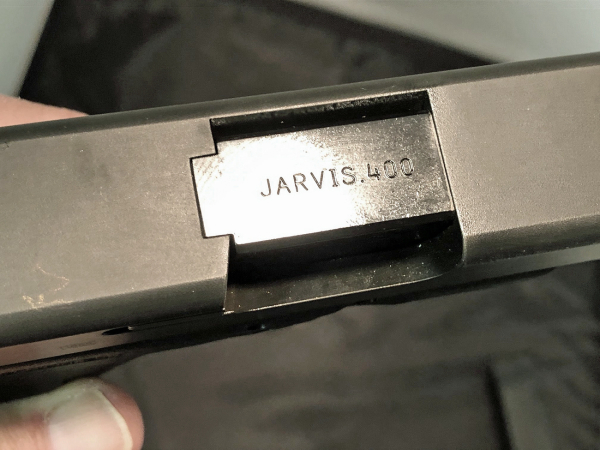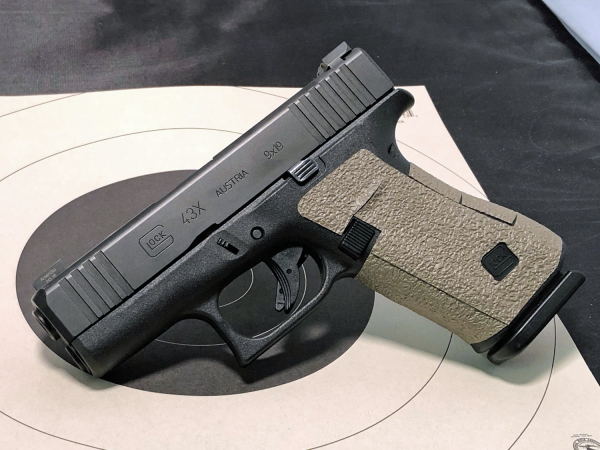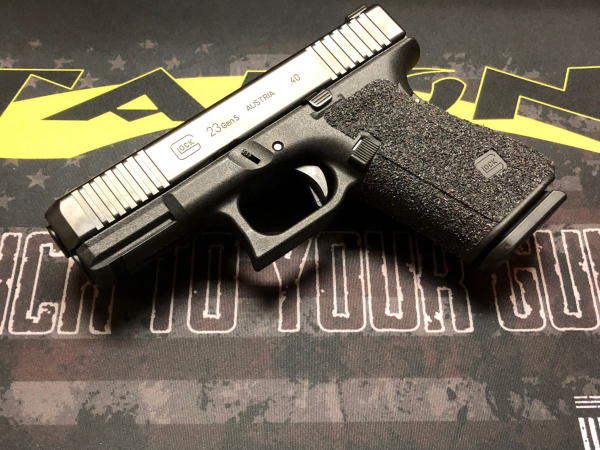Today's feature is from our companion service, The Tactical Wire.

From our recent Shooting Wire coverage on a converted GLOCK 20 10mm – to 357 SIG – it was attempting to follow an idea passed along by Jim Cirillo. The host is a police trade-in GLOCK 20, a factory-stock duty pistol with finish wear with the GLOCK ‘ball in the bucket’ plastic sights. It’s equipped with the NY-1 trigger spring – firm, more than five pounds with the standard connector. It’s also more durable for a coastal environment than the ‘screen door’ coil spring normally used – and this gun allegedly came from an agency in Florida.
The idea was to have one gun that could use a range of calibers - Jim recommended Bill Jarvis for the barrels. The idea was to have ‘multi-fuel’ capability, to use available ammo even if it was a different caliber from the original 10mm. I contacted Bill and he had me ship the slide to him. It returned with a barrel marked “Jarvis 355” and another marked “Jarvis 400.” The gun was now capable of feeding, chambering, extracting and ejecting 10mm, 40 S&W and 357 SIG.
I’d compared shooting the big gun, made before the Gen4 and the “SF” large GLOCK pistols, in 10mm and 357 SIG on my Comparative Standards – explained here. For this trip, I converted the big GLOCK 20 to 40 S&W with the Jarvis barrel. It would be compared to the new Generation 5 GLOCK 23 – slightly wider, heavier slide than previous generation GLOCK pistols in 40 S&W. While I was about it, I’d test other gear – specifically the PRO version of Talon Grips mentioned in yesterday’s Shooting Wire – on the Gen5 GLOCK 23 and the rubber version on the GLOCK 43X 9mm.


Ammunition selection is critical and it’s here that I failed with this test. I grabbed some elderly ammo – Remington Golden Saber 147 gr. HP for the G43x and an old box of Remington “LeadLess” 180gr blunt-nosed FMJ ammo.
I’d fitted the G43x with the more-or-less standard (for me) Talon Grip ‘rubber’ version meant for concealed carry. For the G23, I elected to try the company’s new PRO texture. A combination of the granulate (somewhat abrasive) and rubber (not clingy, but good friction), the PRO is supposed to be the “Goldilocks” zone – more ‘grip’ without abrasion to skin when worn concealed.
While I actually shot a little with each gun before shooting the Standards, I failed to get far enough back to see where the 9mm would hit at ‘operational’ distances. For that reason, I had colossal points down from 25 yards.
It seemed I was under three seconds average for singles from the holster at 25 yards, but was around .2 second slow for hits from ready at fifteen. The ten-yard pair was .13 second overtime and the failure drill took more time than I would like. Up close, the pairs were a little slow, the reload pretty close and the single ‘small target’ hit was right on time. The tardiness combined with penalties to create my issues.
I was fully one-second faster with the Talon product than without – before penalties. There’s more variation in a single pair of runs with the same gun/load/holster, etc. than one second, so it’s effectively a tie. It’ll take more shooting to tell the difference and 9mm is at a premium right now.
The handling was more positive with the grip than without. It’s clear that GLOCK elected to make their slim frames less abrasive than their compact-service and service frames. They’re guns likely to be worn next to the skin.
The GLOCK 20 with the “400 Jarvis” barrel was problematic with the “LeadLess” load. The short 40 feeding up the long follower of the 10mm magazines is susceptible to creating a feedway stoppage. This wasn’t seen with 357 SIG; the pronounced bottleneck allowed slick feeding. The 40 with a more rounded or conical bullet profile feeds pretty well. Blunt nosed ball ammo hangs up with some regularity.
For that reason, it took longer to shoot, but I recorded re-shoots with the G20 instead of the failures. It took under 2.7 seconds average for singles from the holster at 25 yards – but that doesn’t include embarrassing penalties. The singles from ready at fifteen yards were credibly under a second and the pair at ten yards from the holster was dead-on. The reload drill was foul, but the remainder of the close work was good.
The total time wasn’t terrible for a large gun that I seldom shoot – around 36 seconds – but the handling errors increased that time. It’s a real sweetheart when shooting 40 S&W out of the large GLOCK pistol.

Shooting the Gen5 G23 with the Talon Grip Pro was interesting. The hold was grippy and positive -- and not horribly abrasive. I had an error-ridden performance with some classic ‘misses.’ The average ‘single’ at 25 yards was a good 2.4 seconds, but penalties killed me. Singles from ready at 15 yards came in at ¾ second for good hits and the pair at ten yards was better than “good enough,” with no penalties. The remainder chugged along with an embarrassing ‘grab’ at the small target-close range single.
At around 33 seconds, it’s credible speed – with crap accuracy. The Talon Pro was not the issue; it was all the shooter’s problem. The spastic performance still put me ahead of several really soft-shooting guns – again proving the Generation 5 approach to a 40 S&W pistol is a good way to go.
-- Rich Grassi
